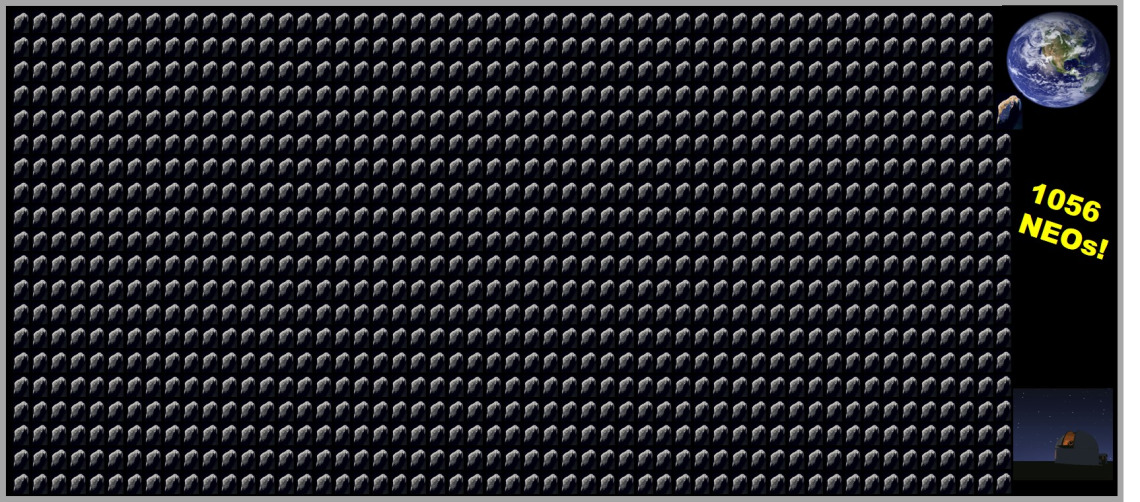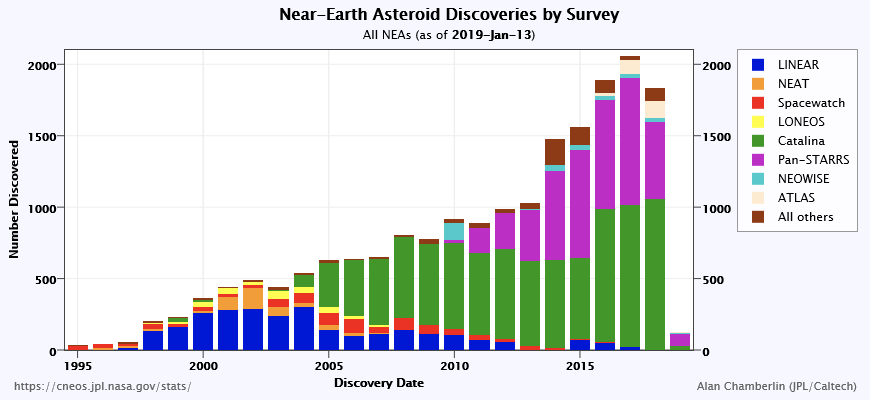In a Record-Setting Year, Catalina Sky Survey Discovers Over 1000 Near Earth Asteroid for 2018!

On the night of December 10, 2018 Catalina Sky Survey (CSS) astronomer Carson Fuls discovered a new near-Earth asteroid (NEO) candidate which he immediately submitted to the Minor Planet Center at Harvard University. After a few nights of additional observations, the object was designated as ‘2018 XK2’ and was determined to be a 40-meter diameter (130 feet) near-Earth asteroid. This sequence of events would be rather routine for CSS astronomers, except that 2018 XK2 turned out to be the 1000th near-Earth Asteroid discovered by the University of Arizona based Catalina Sky Survey in 2018, marking the first time it has surpassed the 1000 NEO mark in its nearly 20-year history. The final 2018 tally for CSS-discovered NEOs stands at a whopping 1056, the largest annual total for any survey in history.
Having come very close in recent years, posting 930 and then 990 near-Earth asteroid discoveries in 2016 and 2017 respectively, it was gratifying for CSS staff to finally surpass the 1000 NEO milestone. The remarkable discovery rate in 2018 and in recent years is largely attributable to CSS’s large 10k x 10k digital cameras on their two survey telescopes which can cover wide swaths of sky night after night. In addition, state-of-the-art moving object detection software is applied by a small team of full-time observers who scan telescope images in real time. This enables NEO candidates to be verified and followed-up rapidly ensuring that the new discoveries are carefully tracked and accurate orbits are determined to improve the ability to recover the objects in the future.

The graph above shows the trajectory of Catalina Sky Survey NEO discoveries since 1995 (green bars) which has been exponential. The increase rate of discovery is attributed to the projects wide field survey telescopes integrated with state-of-the-art electro-optical cameras and detection software, and maintaining a fulltime team of professional observers.
The 1056 new 2018 NEOs range in size from about 2 to 1200 meters (7 to 3900 feet) across. One of them, a small 2-meter (7 feet) asteroid designated ‘2018 LA’ harmlessly impacted the Earth over South Africa on June 10, 2018. This is only the third object in history discovered before impact, the other two also discovered by the Catalina Sky Survey in 2008 and 2014. Additionally, five of the new NEOs are larger than 1 kilometer diameter (3280 feet). New discoveries of NEOs of this size are increasingly rare as most have already been discovered; however they are important discoveries considering the planet-wide destruction that asteroids of this size could inflict if they impacted Earth. Currently no asteroids discovered by CSS or any other survey are on a collision course with the Earth in the foreseeable two centuries. However, considering there are many thousands of near-Earth objects yet to be discovered, the Catalina Sky Survey, and a handful of other surveys are continually watching the nights skies.
The Catalina Sky Survey is a NASA-funded project based at the University of Arizona’s Department of Planetary Sciences, whose mission is to discover and track near-Earth objects.



